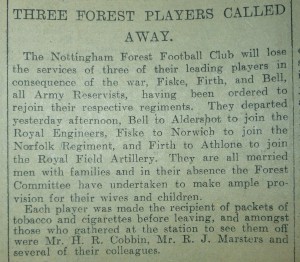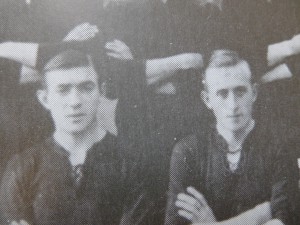August 6, 2014, by Kathryn Steenson
Fighting Footballers
On 6th August 1914, the Nottingham Guardian reported that three Nottingham Forest players, who were Army Reservists, had been called up. Within days of Britain declaring war on Germany they had, along with many hundreds of other Nottinghamshire reservists, left their homes and families to join their regiments.
William Fiske (or Fisk) was born in Suffolk in 1885 to Charles and Sarah Fiske. He had spent the majority of his football career at Blackpool FC, joining Forest as goalkeeper in 1914. He appeared in only a handful of matches before being called up. By 1918 he was a Sergeant with the 8th Battalion Border Regiment, according to the Commonwealth War Graves Commission.
Fiske was reported missing in action on the 27th May 1918, probably killed on the first day of the Third Battle of the Aisne. At the time of his death, his wife of nine years was living in Blackpool. His body was never found and instead he is commemorated on the Soissons Memorial. His is one of almost 4,000 names of officers and men who died during the Battles of the Aisne and the Marne in 1918 who have no known grave.
Robert Edwin Firth, born in 1887, was luckier and returned home to his wife Lily after the war, during which he had reached the rank of Corporal/Acting Sergeant. Before joining Nottingham Forest for the 1911-1912 season, he had previously played for Birmingham City. The right-winger had not actually played a single match in the 1914-1915 season before being called up. After the war, he continued playing for various English clubs after leaving Forest in 1920, then in the 1930s coached several successful Spanish football teams.
More of a mystery is Bell, probably John (Jack) Bell (right) who is pictured next to Firth (left) in this photo of the 1913-1914 team (p.79, ‘Nottingham Forest – The First 125 Years’ by Ken Smales). Although the newspaper article states he was called up, a J Bell definitely played in matches held after this date and was scoring goals in the October and November that year. At least two of the club histories at Manuscripts & Special Collections only mention Firth and Fiske as the first of several Forest players to go to war. Perhaps the newspaper was mistaken, or maybe there was a reason why he was not immediately required for Army service. Whatever happened, Bell lived through the war and continued playing professional football for various clubs into the 1920s.
There is still time to visit our free exhibition at Lakeside Arts Centre. ‘All Quiet in the Weston Gallery‘ explores the First World War using the University’s collections and will close on Sunday 17th August.
No comments yet, fill out a comment to be the first



Leave a Reply